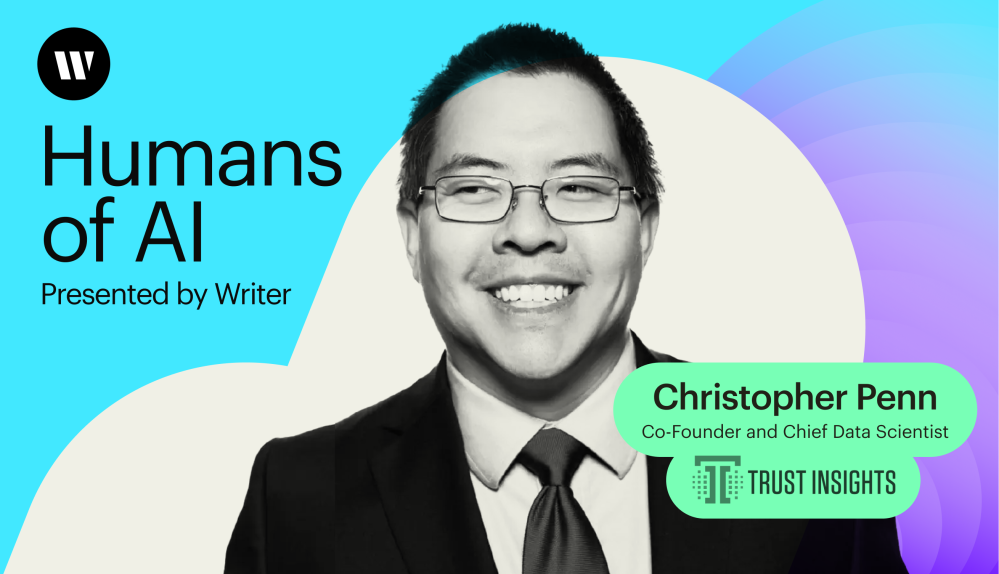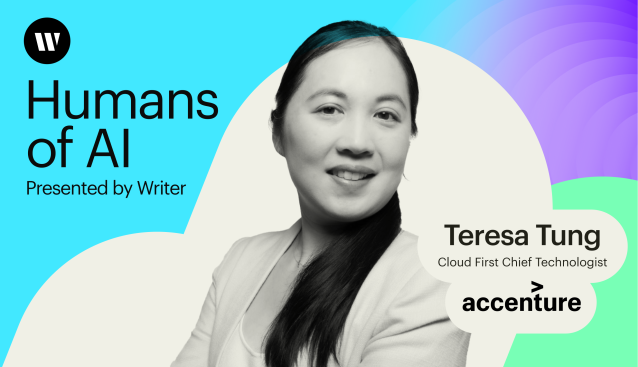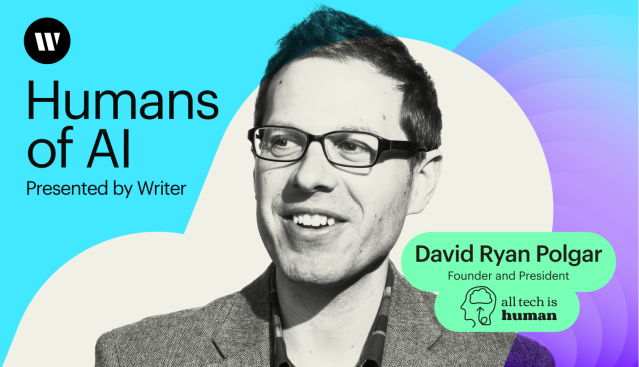Humans in the loop
– 8 min read
How the nerds are leading the AI revolution with Trust Insights’ Christopher S. Penn

In a world full of bullies and business woes, the ultimate weapon is a sharp mind armed with the right tools. It’s a classic underdog tale, but with a tech-savvy twist. Revenge of the Nerds, anyone?
In this edition of Humans of AI, we’re honored to speak with self-proclaimed nerd, Christopher S. Penn. Chris is the Co-Founder and Chief Data Scientist of Trust Insights, a management consulting firm that specializes in analytics and AI. Chris and his team at Trust Insights help companies make use of their data, their technology, and their martech stack, as well as different generative AI platforms and strategies.
Join us as we dive into Chris’ fascinating journey and gain valuable insights into the world of AI. From his early days as an information broker on the playground to his strategic (and some might say mischievous) use of AI on X, Chris shares his insights on the power of data, the limitations of language models, and the importance of grounding businesses in the reality of AI. Get ready to be inspired — and maybe even join the revolution — to explore the transformative potential of AI in your own endeavors.
- Chris shares a childhood story of using data to avoid bullying, highlighting the importance of data and its proper use.
- He discusses his approach to countering biased AI algorithms on platforms like X by strategically injecting his own viewpoints into the training data.
- Chris emphasizes the limitations of language models, emphasizing that they aren’t magic and have no reasoning capabilities.
- He introduces the “5 Ps” framework for evaluating AI solutions for business, focusing on purpose, people, process, platform, and performance.
The power of data and information on the playground
When Chris was in the fifth grade, students passed folded-up notes rather than crafting gossip-filled text messages. Little did he know that navigating the complex world of schoolyard dynamics would ignite his passion for data and its transformative power.
“One of the things that I discovered is that people understand the value of information and the value of data when it applies to them,” Chris reflects. He recognized that information had the potential to shape perceptions, influence decisions — and even protect against bullies.
Chris devised a clever strategy that saved him from the torment of being stuffed into lockers and set the stage for his lifelong journey with data. He tapped into the power of information by becoming an “information broker” on the playground.
After accessing the unguarded locker combinations at his school, Chris photocopied the notes he found in lockers, and used this information to avoid getting bullied.
“Data is important when you use it properly, when you bring it to life,” Chris emphasizes. This early experience laid the foundation for Chris’ belief that data isn’t just a collection of numbers and facts, but a powerful tool that can be harnessed to bring about positive change.
Using AI to battle bullies on X
Chris continues to wield the power of data to take on a different kind of bully. This time, his battleground is X, and his weapon of choice is his unwavering determination to challenge the status quo.
X’s AI platform, Grok — powered by the X data feed — became a focal point for Chris’ battle. The platform’s designers openly acknowledged its alignment with a specific political agenda, one that Chris profoundly disagreed with. Instead of simply canceling his account and walking away, he decided to take a different approach.
He realized that by continuously sharing his political viewpoints via automated messages, he could inject a counterbalance into Grok’s training dataset. “I would just pee in their pool a lot,” Chris explains.
Chris’ strategy goes beyond a single automated message. He plans to use an LLM to generate a priming representation, a specific kind of prompt that further contaminates the data pool with a multitude of concepts. By incorporating his political viewpoints — such as the importance of diversity, trans rights, and healthcare — into the training dataset, he aims to counteract the dominance of a single viewpoint.
The reality of large language models
Chris explains that language models, at their core, are token prediction engines. They excel at predicting the next sequence of tokens based on vast amounts of training data. It’s crucial to recognize that they aren’t magical or sentient beings. They lack reasoning capabilities and true understanding.
“These things are not magic. They’re not sentient, they’re not self-aware,” Chris emphasizes. Language models imitate reasoning and empathy based on their training and tuning. They imitate the appearance of understanding, but their responses are rooted in the patterns and data they’ve been exposed to.
Understanding these limitations is crucial in determining when and how to use language models effectively. They excel in language-related tasks — such as generating summaries, rewriting content, and answering questions. However, they aren’t suitable for tasks outside the realm of language, such as complex mathematical evaluations.
“Just saying, ‘Let’s use AI for something’ is like saying, ‘Let’s use blenders.’ If you’re making steak, that’s probably not a great idea,” Chris explains. “It doesn’t matter how good the blender is, If you want to cook steak, you’re doing it wrong.”
The five Ps framework for AI business solutions
Chris emphasized that it’s not enough to have ad-hoc AI tools at one’s disposal. It’s essential to find the right solution for your unique business needs and operationalize it. To evaluate AI solutions in a crowded market, his co-founder, Katie Robbert, developed a framework called the five Ps: Purpose, People, Process, Platform, and Performance.
“The 5 P framework is what we walk clients through, not just for AI, but for everything because it’s essentially a way to get them to pay attention to what really matters and not get blinded by the shiny object,” Chris says.
This framework helps clients understand what’s important and stay focused on their unique needs, rather than getting distracted by the latest AI trends or products.
To employ the five Ps framework, businesses should:
- Clearly understand their purpose
- Consider the skill levels of the people involved
- Understand the processes that need to be accomplished
- Choose a platform that meets their security and legal requirements
- Measure the performance of the chosen solution
“Don’t just pick the fanciest or the best-known product,” Chris cautions. “Pick the product that meets the legal requirements you have to meet to not get sued—or go to jail depending on where you are.”
Learn more about risk mitigation and AI governance. Check out our guide: Generative AI governance:
a toolkit for enterprise leaders
Evaluating natural language prompts for best performance outcomes
Chris has been working on another framework, one that evaluates different types of natural language prompts for various use cases. This framework takes into account three key measures: readability, lexical diversity, and overall comprehension.
Readability is an essential factor in evaluating prompts. Measures such as Flesch-Kincaid grade level and the SMOG index help determine the grade level at which a piece of content is written.
Lexical diversity, the second measure, focuses on the diversity of language used in prompts. It considers the mix of nouns, verbs, adverbs, and other linguistic elements. Higher lexical diversity indicates more creative writing and a broader vocabulary, which can lead to more engaging and diverse responses from language models.
The third measure, overall comprehension, assesses the comprehensibility of the prompts. Factors such as sentence length, paragraph structure, and formatting play a role in determining how easily the prompts can be understood.
“The piece of code takes in text files and then spits out a CSV file of the different measures, and then a weighted average that I had it put together,” Chris explains. “And what I’m going to be doing with this is writing a series of prompts in all the different formats and all the different recommendations.”
This evaluation framework will help businesses to identify the most effective prompts for their specific use cases. Whether it’s building custom generative AI apps, generating concise action items from conference call transcripts or rewriting sensitive content in a professional tone, the right prompts can significantly enhance productivity and efficiency.
The insights shared by proud nerds like Chris serve as a powerful reminder for all of us to embrace our roles as leaders in the AI revolution. It’s not just about getting ahead or building a better future, it’s about leaning into what makes us nerds. Whether it’s a passion for ethics and policy, a delight in collecting and using data, or a keen interest in research, we all have something to bring with us on this journey into a new era.
Want to hear more stories from the humans working at the crossroads of business and generative AI? Subscribe to Humans of AI wherever you listen to podcasts.


